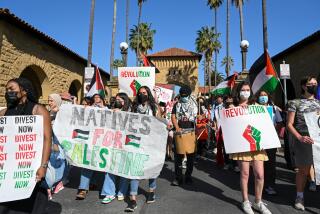It’s Sally Stanford, not Sanford--and also for the record, Errol Flynn didn’t need to be spelled
- Share via
John Howard Steensen is the first to point out that I misspelled Sally Stanford as Sanford the other day in quoting her opinion that former Gov. Edmund G. (Pat) Brown is a man of class.
An inexcusable lapse.
Steensen, a Stanford alumnus, notes that Stanford’s true name was Mabel Busby, and that there was no connection between her professional name and his alma mater.
In that assumption, Steensen is mistaken.
In her lusty autobiography, “The Lady of the House,” the notorious San Francisco madam reveals how she chose the name Sally Stanford.
On a depressing Saturday afternoon she was sitting in Marquard’s bar, trying to cheer herself up, when two things happened. The band played “I Wonder What’s Become of Sally,” and she saw a headline in the late edition of the Call Bulletin: “Stanford Beats California.”
Sally Stanford was born.
Stanford started out as a madam in San Francisco’s Tenderloin, but later moved into a mansion on Nob Hill, next door to the city’s elite, where she ran the classiest house in town. Stanford eloquently defended the morality of her profession: “There’s a book that says we’re all sinners and I at least chose a sin that’s made quite a few people happier than they were before they met me, a sin that’s left me with very little time to consider other extremely popular moral misdemeanors, like usury, intolerance, bearing false tales, extortion, racial bigotry and the casting of that first stone. . . . “
Stanford’s house was patronized by the political and social cream of San Francisco society and by many Hollywood stars. She recalls that Humphrey Bogart was a drunken boor who badgered, belittled and insulted her girls. “We finally had to eighty-six him. No class.”
But she remembers Errol Flynn as “sweet,” and a prodigious lover. “He was the only customer I ever had who tested all of the talent, including both shifts, twice. . . . “
Stanford was in and out of grace with the law and was more than once the victim of trumped-up charges and perjured testimony. When finally her place was raided, she padlocked it and moved across the bay to Sausalito, buying a large old house named Valhalla. Here she opened a restaurant, went straight, was elected to the city council and finally became mayor.
For years Stanford’s liquor license was threatened by a righteous member of the Alcoholic Beverage Control bureau. She was in constant litigation. Then Pat Brown came in as governor and got the ABC off her back.
“It was reported in several papers that the tough, but fair, new governor thought I ran a first-class restaurant; that I had completely rehabilitated myself, and that he could not, in good conscience, oppose the continuation of the license. . . . In my book Pat Brown is a man of courage, style, and class. . . . “
I hope that clarifies the grounds on which Sally Stanford judged that Pat Brown, unlike Humphrey Bogart, had class.
Perhaps no one knew the real San Francisco like Sally Stanford. She despised the postwar migration of Midwesterners who brought their Bible Belt morality with them and tried to suppress the city’s free life style.
“They voted, like the provincials they were, for purity and started the destruction of the spirit of the colorful city that had fascinated them. These are the people who claim that some of us debase ourselves by calling the town ‘Frisco.’ The real San Franciscans . . . have never called it anything but Frisco.”
Perhaps the real sinners were the illustrious robber barons who occupied the other houses on Nob Hill, among them Leland Stanford himself. Stanford was one of the Big Four who built the Central Pacific and the Southern Pacific railroads and held the entire economy of the state in their monopolistic grip. They built their railroads with cheap Chinese labor, charged exorbitant freight rates and with false promises lured thousands of migrant farmers west to farm the parched government-owned land of the San Joaquin Valley along their tracks; later, when the railroads obtained title to the now-productive land, they sold it to the highest bidders. When a group of angry farmers confronted the railroad’s gunmen one morning in the Tulare basin, seven were shot and killed.
Meanwhile, Stanford rolled about the country in his luxurious private car, saluted like a monarch at every siding. He was perhaps the most profligate spender in the West. He erected four extravagant mansions, laid out a 55,000-acre vineyard that failed, raised thoroughbred horses, traveled widely and built Stanford University as an alternative to the state-run University of California.
Although Stanford imagined himself the leader of the Big Four, and played the role, he was in fact a mere front man, having some stature as a former governor of the state; the hard-nosed, self-effacing Collis P. Huntington, the real power in the railroad empire, dismissed him as “a damned old fool.”
It may be of some comfort to Stanford graduates to know that their alma mater was not named for the showboat Leland Stanford, but for his son, Leland Stanford Jr., a youth of promise, modesty and precocious good taste, who died at 15 in Florence, Italy.
Sally Stanford was not without her academic credentials. Steensen recalls that he and an Oakland newspaperman friend once took the friend’s visiting sister to Stanford’s Valhalla and introduced her to the proprietress as dean of women at Boston University, which she was.
Stanford, who was wearing half a dozen orchids in her hair, gave her a practiced once-over and said, “Pleased to meetcha, dearie--I used to be in that business myself.”
More to Read
Sign up for Essential California
The most important California stories and recommendations in your inbox every morning.
You may occasionally receive promotional content from the Los Angeles Times.













